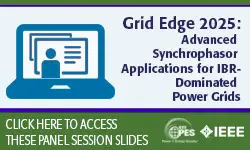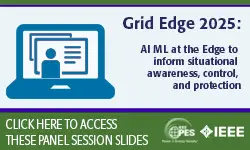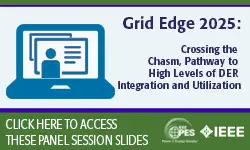-
Members: FreePES
IEEE Members: $25.00
Non-members: $40.00Pages/Slides: 65
Panel
14 Sep 2022
This panel session contains the following presentations:
1. Enhancing Performance of Compressive Sensing-Based State Estimators Using Dictionary Learning
Smart grids integrate computing and communication infrastructure with conventional power grids to improve situational awareness, control, and safety. Several technologies such as automatic fault detection, automated reconfiguration, and outage management require close monitoring of the network. Utilities require measurements from sensing equipment such as PMUs (phasor measurement units), smart meters, and bellwether meters to achieve these objectives. However, this expansion in sensing equipment results in increased strain on existing communication infrastructure. Previous works on reducing this strain have exploited the sparsity of the power consumption data in the Haar, Hankel, and Toeplitz transformation bases to achieve sub-Nyquist compression. However, data-driven dictionaries enable superior compression ratios and reconstruction accuracy by learning the data's sparsifying basis. Therefore, this work proposes using dictionary learning to learn the sparsifying basis of smart meter data. Compressive sensing-based estimators can then utilize these compressed measurements to estimate the system states. This approach was validated on the IEEE 33-node distribution system and showed superior reconstruction accuracy over conventional transformation bases and overcomplete dictionaries. Voltage magnitude and angle estimation error less than 0.3% mean absolute percentage error and 0.04 degree mean absolute error, respectively, at compression ratios as high as eight, were achieved by using the proposed method..
2. Testing & Commissioning of Digital Substation - IEC 61850-9-2 LE Complied IEDs & Merging Units
Power system protection has undergone a huge revolution in the recent times owing to the advancements happening in the communication technology and the standards defined by international committees. One such standard defined by IEC61850 has been under extensive implementation in many parts of the world. The standard has segregated the implementation methods in chapter 8-1 for digital information transfer and chapter 9-2 for analog information transfer between the protection, control and switchgear equipment. This has led to reduction and elimination of copper cable in the substation which has been in the form of panel wiring, inter panel wiring and cables between switchyard to control room. The panel wiring was minimized by the use of advance features available in numerical relays, and the inter panel wiring has been diminished by the use of relay to relay communication defined as generic object-oriented substation event (GOOSE) in IEC61850-8-1. Further, the copper cable elimination was also defined in IEC61850-9-2 by use of equipment such as merging units and optical current / voltage transformers. This equipment provides the option for the user to eliminate huge cost due to reduction of copper cables, and compact solution with minimum equipment without compromising the quality delivered. Such a substation would be categorized as digital substation [1] and the high-end communication gateway would further provide the user the option to run the substation from remote (Unmanned substations) On the other hand, the implementation of such a system throws challenges to the users when products from various vendors are integrated and is to be tested in accordance to the specification and that of the standard. This challenge is addressed to a certain extent by the light edition of IEC61850-9-2 defined as IEC61850-9-2LE [2]. In accordance to this standard, the major components such as intelligent electronic devise, merging unit, optical / conventional current and voltage transformers, ethernet switch, time synchronization equipment etc.. has to be tested and commissioned. The step by step testing methodology involved in testing of the major components of digital substation in accordance to IEC61850-9-2LE standard is the attempt and scope of this paper.
3. Synchrophasor Estimation: Review, Limitations and Future Trends
This paper presents a state-of-the-art literature review on the existing synchrophasor estimation techniques, targeted to be used in Phasor Measurement Units (PMUs) in Wide Area Monitoring Systems (WAMS). Building upon the research gaps in the existing literature, the paper also highlights the latest trends and also, the future research directions in synchrophasor estimation.. The study result shows that the proper installation of the protective device allows for managing the overvoltage level and energy within devices' ratings.
1. Enhancing Performance of Compressive Sensing-Based State Estimators Using Dictionary Learning
Smart grids integrate computing and communication infrastructure with conventional power grids to improve situational awareness, control, and safety. Several technologies such as automatic fault detection, automated reconfiguration, and outage management require close monitoring of the network. Utilities require measurements from sensing equipment such as PMUs (phasor measurement units), smart meters, and bellwether meters to achieve these objectives. However, this expansion in sensing equipment results in increased strain on existing communication infrastructure. Previous works on reducing this strain have exploited the sparsity of the power consumption data in the Haar, Hankel, and Toeplitz transformation bases to achieve sub-Nyquist compression. However, data-driven dictionaries enable superior compression ratios and reconstruction accuracy by learning the data's sparsifying basis. Therefore, this work proposes using dictionary learning to learn the sparsifying basis of smart meter data. Compressive sensing-based estimators can then utilize these compressed measurements to estimate the system states. This approach was validated on the IEEE 33-node distribution system and showed superior reconstruction accuracy over conventional transformation bases and overcomplete dictionaries. Voltage magnitude and angle estimation error less than 0.3% mean absolute percentage error and 0.04 degree mean absolute error, respectively, at compression ratios as high as eight, were achieved by using the proposed method..
2. Testing & Commissioning of Digital Substation - IEC 61850-9-2 LE Complied IEDs & Merging Units
Power system protection has undergone a huge revolution in the recent times owing to the advancements happening in the communication technology and the standards defined by international committees. One such standard defined by IEC61850 has been under extensive implementation in many parts of the world. The standard has segregated the implementation methods in chapter 8-1 for digital information transfer and chapter 9-2 for analog information transfer between the protection, control and switchgear equipment. This has led to reduction and elimination of copper cable in the substation which has been in the form of panel wiring, inter panel wiring and cables between switchyard to control room. The panel wiring was minimized by the use of advance features available in numerical relays, and the inter panel wiring has been diminished by the use of relay to relay communication defined as generic object-oriented substation event (GOOSE) in IEC61850-8-1. Further, the copper cable elimination was also defined in IEC61850-9-2 by use of equipment such as merging units and optical current / voltage transformers. This equipment provides the option for the user to eliminate huge cost due to reduction of copper cables, and compact solution with minimum equipment without compromising the quality delivered. Such a substation would be categorized as digital substation [1] and the high-end communication gateway would further provide the user the option to run the substation from remote (Unmanned substations) On the other hand, the implementation of such a system throws challenges to the users when products from various vendors are integrated and is to be tested in accordance to the specification and that of the standard. This challenge is addressed to a certain extent by the light edition of IEC61850-9-2 defined as IEC61850-9-2LE [2]. In accordance to this standard, the major components such as intelligent electronic devise, merging unit, optical / conventional current and voltage transformers, ethernet switch, time synchronization equipment etc.. has to be tested and commissioned. The step by step testing methodology involved in testing of the major components of digital substation in accordance to IEC61850-9-2LE standard is the attempt and scope of this paper.
3. Synchrophasor Estimation: Review, Limitations and Future Trends
This paper presents a state-of-the-art literature review on the existing synchrophasor estimation techniques, targeted to be used in Phasor Measurement Units (PMUs) in Wide Area Monitoring Systems (WAMS). Building upon the research gaps in the existing literature, the paper also highlights the latest trends and also, the future research directions in synchrophasor estimation.. The study result shows that the proper installation of the protective device allows for managing the overvoltage level and energy within devices' ratings.
Chairs:
Prof Izham Z. Abidin


